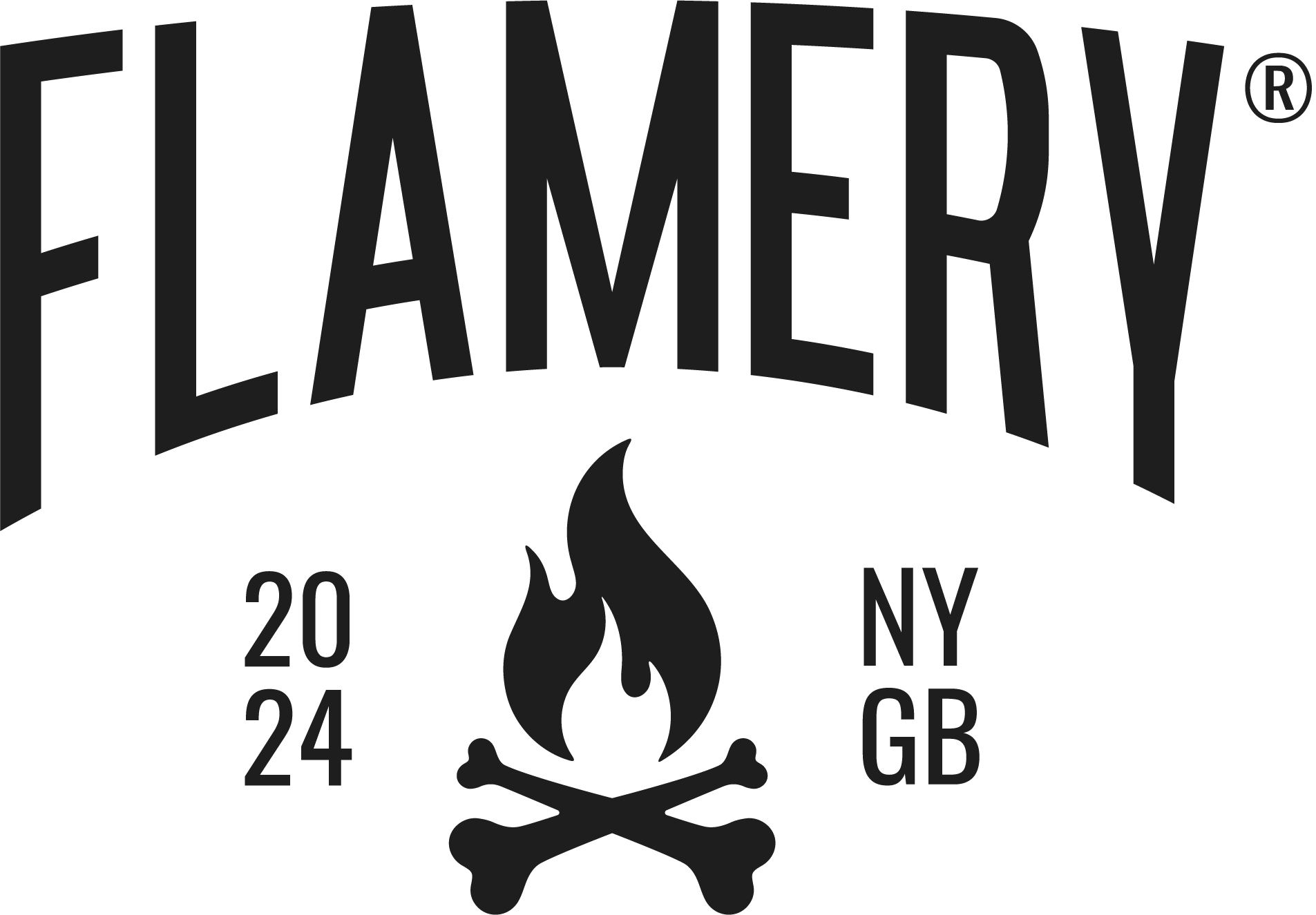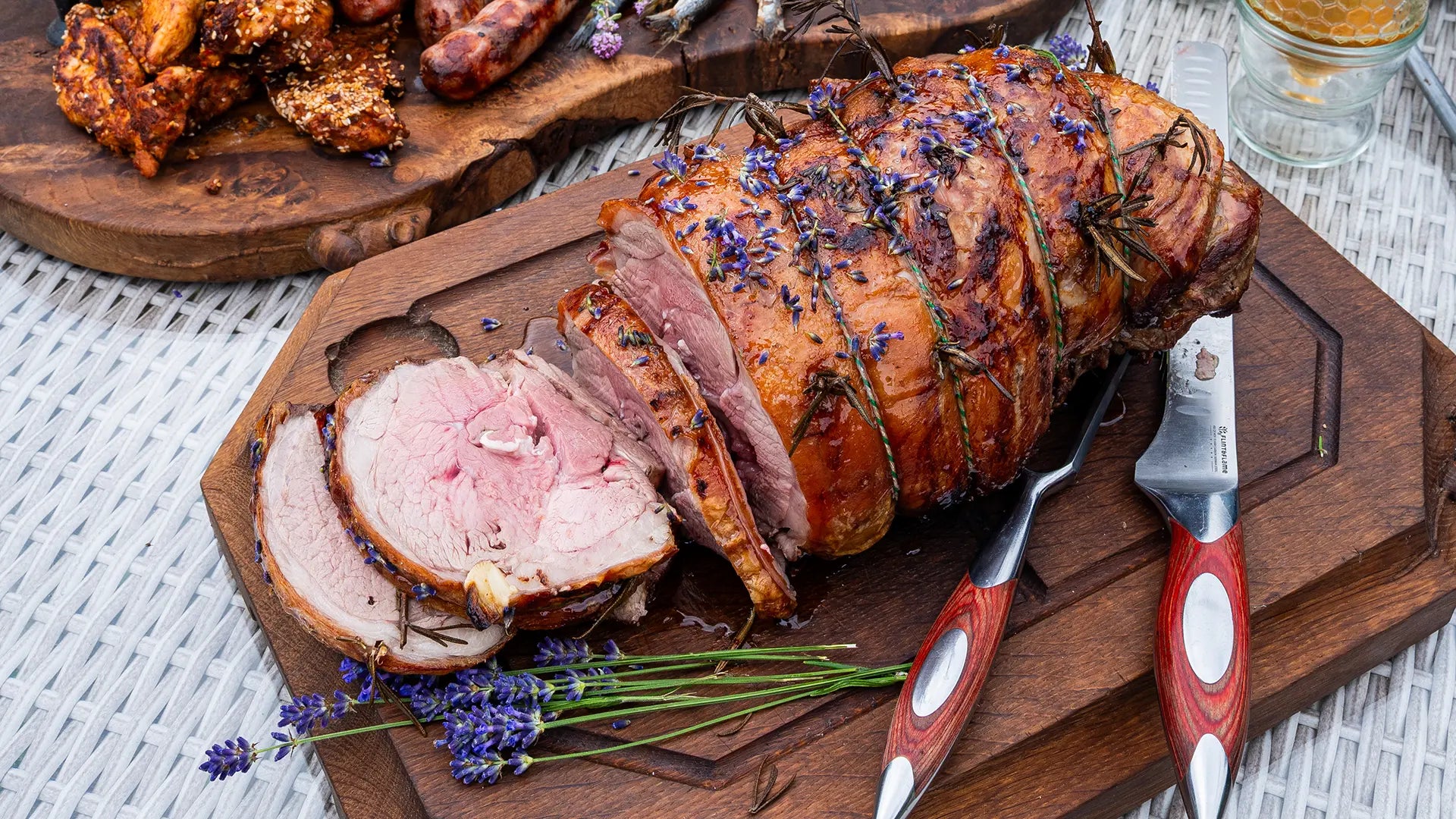Slow-roasted, self-basting lamb with a glossy rosemary-honey lacquer. The rotisserie keeps it juicy, the flames add smoke, and the finish is sticky, savoury and a little bit sweet.

What You’ll Need
Feeds 6–8 (or 4 with glorious leftovers)
For the lamb
- 1 boned & rolled lamb shoulder, 2.5–3 kg (butcher’s string on)
- 2 tsp sea salt flakes
- 1 tsp cracked black pepper
- 1 tbsp fennel seeds, lightly crushed (optional)
- 4 cloves garlic, minced
- Zest of 1 lemon
- 2 tbsp olive oil
Rosemary–Honey Baste
- 120 g runny honey
- 2 tbsp fresh rosemary, very finely chopped (plus extra sprigs for the fire)
- 2 tbsp apple cider vinegar (thins the honey so it doesn’t scorch)
- 1 tbsp Dijon mustard
- 1 tbsp olive oil
- Pinch of chilli flakes (optional)
- Sea salt & black pepper, to taste
To serve (optional)
- Flatbreads or roast potatoes (see Tips)
- Lemon wedges, extra rosemary, flaky salt
The Set-Up

- Grill: Flamery Asado (any model)
-
Attachment: Flamery Rotisserie Kit or Rotisserie Frame Kit (motor rated to 15 kg; 8 mm stainless skewer, heavy-duty forks)
- Fuel: Quality lumpwood charcoal with a couple of hardwood chunks for aroma
- Grate/Extras: Drip tray (for potatoes or to catch juices), heat-proof gloves, probe thermometer
Light your fire and build an even, medium bed of coals. You’re aiming for a gentle roasting environment at the meat: roughly 170–190°C in the rotisserie zone. Bank coals to the sides for indirect heat.
How to Cook It
- Season & Skewer: Mix salt, pepper, fennel seeds, garlic, lemon zest and olive oil into a paste. Pat the lamb dry, rub all over, and re-tie any loose sections so the roll is neat and even. Slide onto the rotisserie skewer and lock with forks; ensure it’s centred and balanced.
- Make the Baste: Whisk honey, rosemary, vinegar, mustard, olive oil and chilli flakes with a pinch of salt and pepper. Set aside.
- Roast on the Rotisserie: Mount the skewer and start the motor. Position the lamb so it turns in indirect heat above the drip tray. Add a couple of rosemary sprigs to the coals for aromatic smoke. Roast for ~1 hr before your first glaze — this lets the exterior set so the honey won’t burn.
-
Glaze & Finish: Begin basting every 10–15 minutes, layering on thin coats. Top up coals as needed to hold that steady medium heat.
- For sliceable, tender lamb: cook to 80–85°C internal.
- For soft, shred-able lamb: continue to 90–93°C internal.
- (Shoulder is rich in collagen; these higher temps melt it for tenderness.
- Total time is typically 1¾–2½ hours depending on size, fire and weather.
- Rest: Come off the heat, tent loosely with foil and rest 20–30 minutes. Brush with a last slick of warm glaze.
Serve It Up
Slice thickly (or pull into chunks if cooked to shred-able), scatter with flaky salt and chopped rosemary. Squeeze over lemon. Pile into flatbreads with peppery leaves and yoghurt, or serve with fire-roasted potatoes drenched in the drippings.
Bonus Tips
- Drip-tray potatoes: Parboil baby potatoes, rough them up, and roast in the tray beneath the lamb so they baste in lamb juices and honey-rosemary glaze. Stir occasionally.
-
Heat control: If the glaze threatens to darken too fast, raise the spit (Frame Kit) or pull some coals to reduce intensity.
-
Balance matters: Centre the joint on the skewer and tighten forks to avoid wobble and motor strain for smooth, even cooking.
- Make-ahead: Season and roll the day before; keep uncovered in the fridge for crisper skin/bark.



Share:
Surf & Turf on the Konro Grill